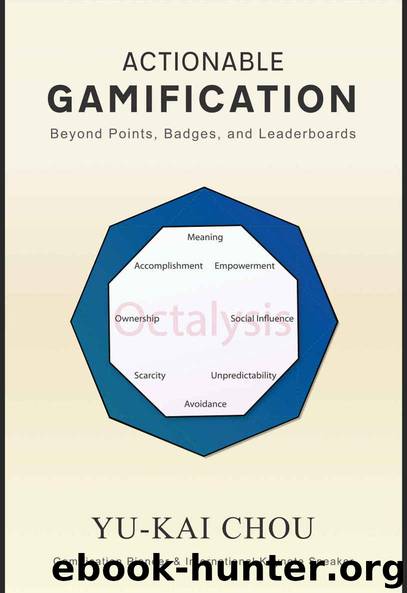Actionable Gamification: Beyond Points, Badges, and Leaderboards by Yu-kai Chou

Author:Yu-kai Chou
Language: eng
Format: epub, mobi, azw3
Publisher: Octalysis Media
Published: 2015-04-15T14:30:00+00:00
“I Don’t Feel Good When My Pocket Is Too Full After A Purchase”
This situation doesn’t just happen with high-end services. In the book Influence: Science and Practice, Robert Cialdini also describes a story of a friend who ran an Indian jewelry store in Arizona that tried to sell some high quality turquoise pieces during the peak tourist season8.
Despite her constant efforts to promote, cross-sell, and emphasize these pieces to shop visitors, no one seemed interested in purchasing them. Finally, the night prior to an out-of-town buying trip, the owner concluded that she needed to lower the prices and make the pieces more attractive to her customers. As a result, she left a note for her head salesperson with instructions to reduce the prices by “x½.”
However, the salesperson misunderstood the note, and mistakenly doubled the price instead. Upon returning a few days later, the owner was pleasantly surprised to learn that all the pieces had been sold. Doubling the price on each item had actually allowed her to sell more because their perceived value had increased.
Since you don’t do anything with jewelry other than show it off to others (or yourself), the value is usually based on perception as opposed to functionality. You may quickly dismiss the value of an ugly and cracked pottery piece on the shelf, until someone told you that it was made 1,200 years ago for a historically significant event. The pottery itself did not functionally or aesthetically become more valuable, but its perceived value immediately went up due to the principles of scarcity.
Up to this point, you may have observed that the high-price principle within Core Drive 6 works powerfully for luxury items that serve little functional purpose such as jewelry, or expensive services that provide essential expertise. Surprisingly, it also works with everyday functional items.
Just a week prior to writing this chapter, upon realizing my knee pains were getting worse, I decided to visit a sports utility store. I wanted pick up some knee braces for hiking or when I’m walking up and down the stairs during phone meetings. When I entered the store, I saw that there were two types of braces, one for $24.99 one another for $49.99.
I thought to myself, “Well, my knees are very important to me. I better not spare a few extra bucks and end up with busted knees down the road.” As an extension to this thought, I reached out for a pair of $49.99 braces and bought them.
It didn’t occur to me until writing this chapter and searching for examples, that I automatically assumed that the more expensive knee braces were better than the cheaper ones. I didn’t even bother to carefully read the product descriptions. If you were to ask me how the $49.99 one was better than the $24.99 one, I wouldn’t be able to give you an answer. I would likely say something along the lines of, “Well, the $49.99 one is more expensive, so I’m sure it offers better protection for my knees or feels more comfortable.
Download
Actionable Gamification: Beyond Points, Badges, and Leaderboards by Yu-kai Chou.mobi
Actionable Gamification: Beyond Points, Badges, and Leaderboards by Yu-kai Chou.azw3
This site does not store any files on its server. We only index and link to content provided by other sites. Please contact the content providers to delete copyright contents if any and email us, we'll remove relevant links or contents immediately.
POP by Steven Heller(3214)
Japanese Design by Patricia J. Graham(2976)
The Power of Broke by Daymond John(2741)
Architecture 101 by Nicole Bridge(2683)
Indistractable: How to Control Your Attention and Choose Your Life by Nir Eyal(2258)
Fusion 360 for Makers by Lydia Sloan Cline(2219)
Actionable Gamification: Beyond Points, Badges, and Leaderboards by Yu-kai Chou(2054)
Batik by Rudolf Smend(1990)
Origami Art by Michael G. Lafosse & Richard L. Alexander(1986)
Homebody by Joanna Gaines(1971)
Whiskey in a Teacup by Reese Witherspoon(1855)
Feng Shui by Stephen Skinner(1845)
Worn in New York by Emily Spivack(1826)
Austin Kleon by Steal Like an Artist(1804)
Simple Gatherings by Melissa Michaels(1767)
Don't Make Me Think, Revisited: A Common Sense Approach to Web Usability by Steve Krug(1760)
Hygge: The Danish Art of Happiness by Marie Tourell Søderberg(1627)
The Joy of Hygge by Jonny Jackson(1597)
The Laws of Simplicity by John Maeda(1504)
